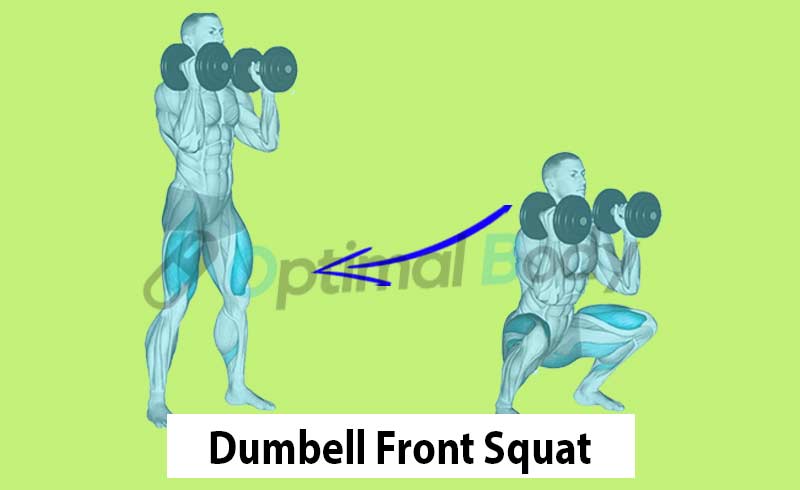Front squats are an excellent way to strengthen your legs and core, and the dumbbell front squat is a variation of this exercise that’s both effective and accessible.
In this article, we’ll break down what the dumbbell front squat is, how to do it correctly, the muscles it works, and the benefits it offers.
Exercise Details
- Also known as: Dumbbell front squat
- Exercise type: Strength
- Body type: Legs
- Level: Beginner to Intermediate
- Main targets: Quadriceps (front thigh muscles), glutes (butt muscles), calves
- Secondary targets: Abs (core), hamstrings (back thigh muscles), lower back
- Compound/Isolated: Compound
- Force type: Push
- Required equipment: Dumbbells
What Is a Dumbbell Front Squat?
Unlike traditional squats where you place a barbell on your upper back, the dumbbell front squat involves holding dumbbells in front of your body at shoulder height. This shift in weight distribution engages your core and challenges your upper body, making it a great exercise for overall strength.
Front squats, including the dumbbell version, require good posture and upper body strength, making them suitable for those looking to develop these areas.
Dumbbell Front Squats Muscles Worked
Dumbbell front squats are effective at targeting several muscle groups, including:
- Quadriceps: The front thigh muscles are heavily engaged as you bend and straighten your knees.
- Glutes: Your butt muscles get a good workout during the squat.
- Calves: These lower leg muscles come into play as you push yourself back up.
Benefits of Performing Front Dumbbell Squat
- Full-Body Strength: Dumbbell front squats provide a comprehensive workout, targeting both your lower body and upper body.
- Core Strength: Balancing the dumbbells in front of you engages your core, helping improve stability and strength in your midsection.
- Posture Improvement: Regularly doing front squats can enhance your posture and alleviate issues related to poor posture.
- Increased Mobility: This exercise can improve your flexibility and range of motion, making everyday movements easier.
- Functional Fitness: Dumbbell front squats mimic natural body movements, making them valuable for functional fitness and daily activities.
How to Do a Dumbbell Front Squat Properly
- Stand with your feet shoulder-width apart, holding a dumbbell in each hand at shoulder height. Ensure your elbows are pointed forward.
- Slowly lower your body by bending your knees, keeping your back straight, chest up, and core engaged. Go as low as your flexibility allows, ideally until your thighs are parallel to the ground.
- Keep your knees aligned with your toes and avoid letting them cave inwards. Your weight should be on your heels, not your toes.
- Push through your heels to stand back up, straightening your legs. Maintain a strong core throughout the movement.
- Aim for 3 to 5 sets of 8 to 10 repetitions to start. Adjust the weight to suit your fitness level.
Pro Tips:
- Keep your heels flat on the ground throughout the exercise.
- Maintain good posture by keeping your chest up and elbows pointed forward.
Variations of the Dumbbell Front Squat
The dumbbell front squat is a versatile exercise that can be modified to add variety to your workout routine, targeting different muscle groups and accommodating various skill levels. Let’s explore these variations and how to perform each one:
1. Dumbbell Goblet Squats
The goblet squat is an ideal variation for beginners and experts alike.
Here’s how to do goblet squat:
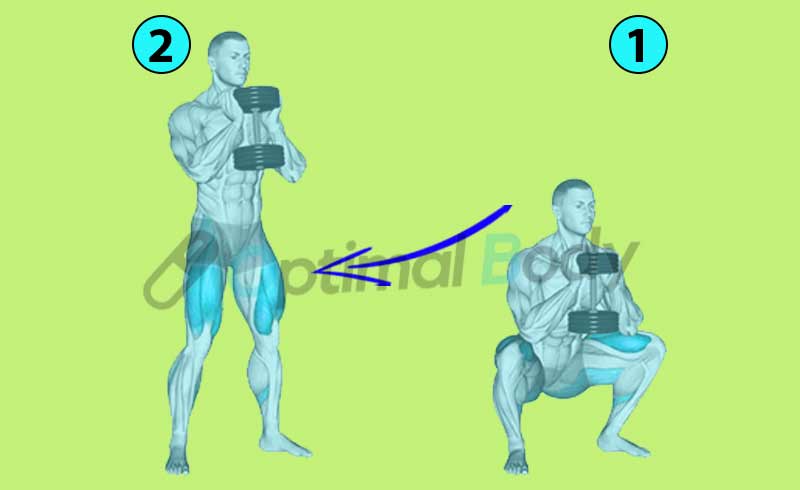
- Start by holding a single dumbbell vertically with both hands at chest level, close to your body.
- Stand with your feet shoulder-width apart.
- Keep your chest up, and core engaged, and maintain proper posture throughout the exercise.
- Lower your body by bending your knees and hips while keeping the dumbbell close to your chest.
- Lower yourself as much as your flexibility permits, aiming for your thighs to be parallel to the ground if possible.
- Then, use your heels to propel yourself back into a standing position.
Benefits: Goblet squats promote balance, posture, and core engagement due to the front-loaded weight. They are excellent for beginners while still challenging for more experienced lifters.
2. Crush Grip Goblet Squat
To intensify the challenge of goblet squats, you can try this variation.
How to crush grip goblet db squats:
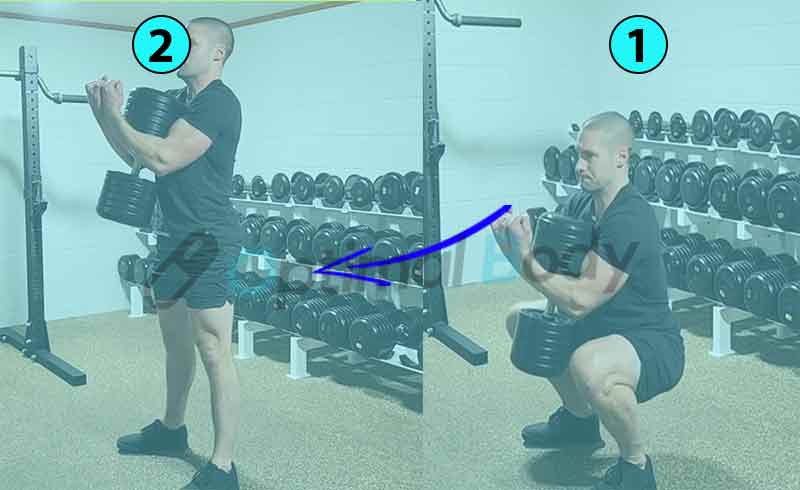
- Perform the goblet squat as described above.
- Instead of holding the dumbbell vertically, hold it horizontally with both hands, squeezing it tightly.
- This variation further engages your grip strength and forearm muscles.
Benefits: The crush grip goblet squat adds an extra challenge to your core and grip strength.
3. Heels-Elevated Front Squat With Dumbbells
Elevating your heels during front squats alters muscle engagement and enhances mobility.
Here’s how to do heels elevated db front squat:
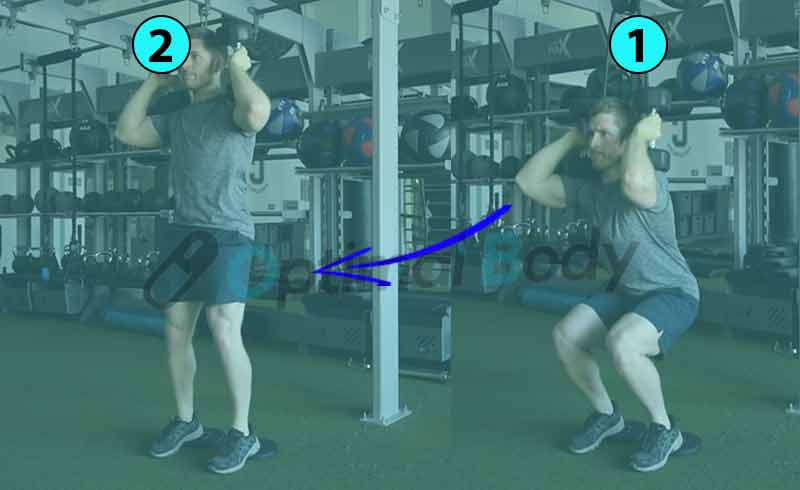
- Place your heels on a small platform, such as a weight plate or step.
- Grip a dumbbell in each hand either at shoulder height or alongside your body.
- Perform the front squat as usual, maintaining good posture and keeping your chest up.
- The elevated heels emphasize the quadriceps and other leg muscles.
Benefits: Heels-elevated front squats improve lower body mobility and flexibility while targeting specific leg muscles.
4. Dumbbell Zercher Squat
The dumbbell Zercher squat is an advanced variation that challenges both the upper body and core.
Here’s how to perform the Zercher squat:
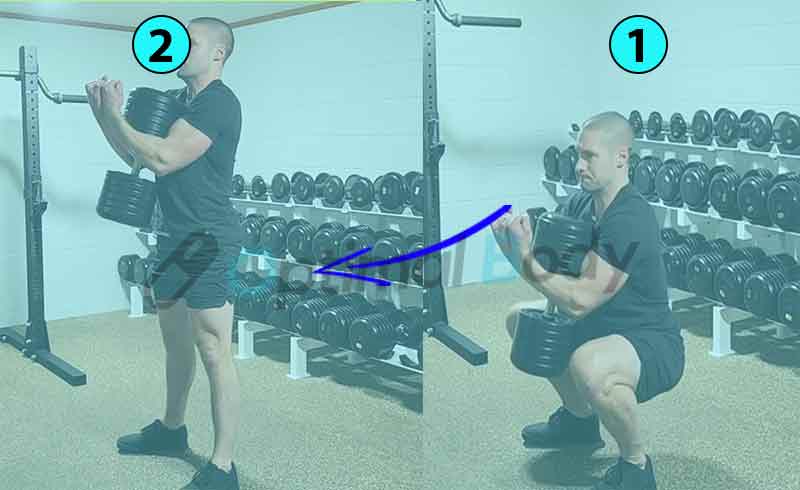
- Hold a dumbbell in the bend of your elbows, maintaining close proximity of your elbows to your body.
- Stand with your feet shoulder-width apart.
- Maintain proper posture and engage your core.
- Descend into a squat by flexing your knees and hips. Just like in any other squat variation, strive to descend as far as your flexibility permits.
- Finally, push to return to a standing position.
Benefits: The Zercher squat is a robust, full-body exercise that increases the demand on your upper body and core.
5. Dumbbell Squat
The classic dumbbell squat entails grasping a dumbbell in each hand positioned alongside your body.
Here’s how to do a dumbbell squat:
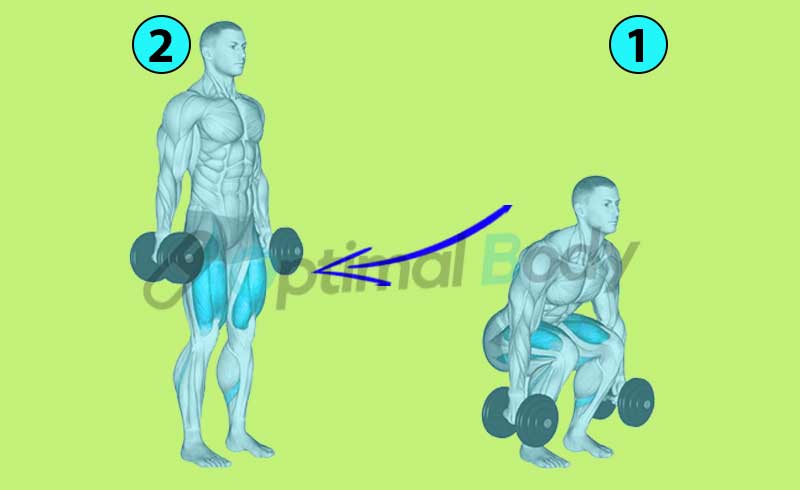
- Grasp a dumbbell in each hand, extending your arms fully down by your sides.
- Stand with your feet shoulder-width apart.
- Maintain proper posture, keeping your chest up and core engaged.
- Perform the squat by bending your knees and hips while keeping the dumbbells by your sides.
- Go as low as your flexibility allows.
- ascend back to the standing position.
Benefits: This variant primarily targets the lower body, activating the glutes and hamstrings, making it a valuable addition to leg training routines.
Remember to choose the variation that suits your strength level and fitness goals.
Top DB Front Squat Alternatives
1. Cross-Arm Front Squat
The cross arm front squat is an alternative to the traditional front squat, designed for individuals who lack the wrist mobility required for the front rack position.
How To Do It:
- Position the barbell on the front of your shoulders in the squat rack.
- Cross your arms in front of you, placing your fingers over the top of the bar without wrapping your hands around it.
- Lift the bar out of the rack, ensuring your elbows are raised toward the ceiling to prevent the bar from slipping.
- Stand with your feet just outside hip-width, toes pointing forward or slightly turned out.
- Lower your hips until they are approximately parallel to the ground, keeping your entire foot on the ground.
- Push through your feet while lifting your chest and elbows toward the ceiling to return to the starting position.
2. Front Squat with Cable
A front squat with a cable machine is an exercise that targets various leg muscles and engages the upper body by using a cable machine instead of a barbell.
How To Do It:
- Stand with your feet parallel, shoulder-width apart, and toes pointing forward.
- Keep your knees over your toes as you begin the squat.
- Maintain a tight lower back, keep your chest up, and flex your arms with your hands at shoulder level.
- Grasp the cable handles with the desired weight.
- Squat down while keeping your chest upright and inhaling.
- Stand up, fully extending your knees, and exhale.
3. Barbell Front Squat
The barbell front squat is a powerful lower body and core strength exercise. It primarily targets the quadriceps while engaging the hamstrings, glutes, core, and upper body to a degree.
It’s favored by athletes, bodybuilders, and powerliftersfor its effectiveness in improving leg strength, stability, and overall development.
How To Perform:
- Set the barbell at shoulder height in the squat rack.
- Stand facing it with feet shoulder-width apart.
- Position the bar on your front shoulders, just above the collarbone.
- Cross your arms over the bar, creating a shoulder “shelf.”
- Grip the bar, keeping elbows high.
- Lift it off the rack and step back.
- Keep an upright torso and initiate the squat by bending hips and knees.
- Lower until thighs are parallel to the ground.
- Maintain weight on your heels.
- Push through heels to stand up, extending knees and hips.
In Conclusion
Incorporating dumbbell front squats into your workout routine can be a game-changer for your overall strength and fitness.
References:
- Khan A, Arain A. Anatomy, Bony Pelvis and Lower Limb: Anterior Thigh Muscles. [Updated 2023 Mar 17]. In: StatPearls [Internet]. Treasure Island (FL): StatPearls Publishing; 2023 Jan-. Available from: https://www.ncbi.nlm.nih.gov/books/NBK538425/
- Schoenfeld BJ, Contreras B, Vigotsky AD, Peterson M. Differential Effects of Heavy Versus Moderate Loads on Measures of Strength and Hypertrophy in Resistance-Trained Men. J Sports Sci Med. 2016 Dec 1;15(4):715-722. PMID: 27928218; PMCID: PMC5131226.
- Gullett JC, Tillman MD, Gutierrez GM, Chow JW. A biomechanical comparison of back and front squats in healthy trained individuals. J Strength Cond Res. 2009 Jan;23(1):284-92. doi: 10.1519/JSC.0b013e31818546bb. PMID: 19002072.
- Bench Press Calculator - April 22, 2024
- Press to Handstand: Ultimate Step-by-Step Guide - April 22, 2024
- Cable Press (How To Do, Benefits, Targeted Muscles, Alternative) - April 22, 2024

